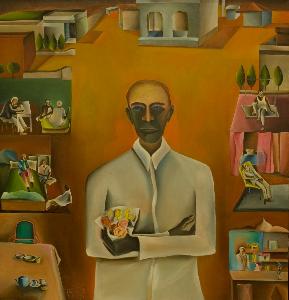Bhupen Khakkar
Bhupen Khakkar;Bhupen Khakhar
Place: Bombay
Born: 1934
Death: 2003
Biography:
Bhupen Khakhar was a renowned Indian artist, born in Bombay in 1934. He is widely regarded as 'India's first Pop artist', and his work gained international recognition for its unique blend of traditional Indian themes and modern pop art elements.
Early Life and Career
Khakhar was a self-trained artist who started his career as a painter relatively late in his life. His works were figurative in nature, concerned with the human body and its identity. He was openly gay, which is reflected in some of his paintings that explore themes of sexuality and identity.
Artistic Style
Khakhar's artistic style was characterized by bold colors and bold forms, often incorporating elements of Indian mythology and folklore. His paintings were a fusion of traditional Indian art and modern pop art, making him a pioneer in the Indian art scene. Some of his notable works include Bhabhiji, which is now considered an iconic representation of Indian pop art.
Notable Works and Exhibitions
Khakhar's work has been exhibited at various museums and galleries, including the National Gallery of Modern Art in New Delhi. His paintings are also part of the collection at the Baroda Museum and Picture Gallery. Some of his notable works can be found on Wikioo.org, which showcases a wide range of his paintings.
Awards and Recognition
Khakhar received numerous awards and recognition for his work, including the Padma Shri award in 1983. He was also awarded the Lalit Kala Akademi fellowship in 1991.
Legacy
Khakhar's legacy as a pioneer of Indian pop art continues to inspire artists today. His work can be seen as a reflection of the changing social and cultural landscape of India during the 20th century. As an artist, he played a significant role in shaping the Indian art scene, and his paintings continue to be celebrated for their bold colors, bold forms, and exploration of themes that were previously considered taboo.
- Some of Khakhar's notable works can be found on Wikioo.org.
- His paintings are also part of the collection at the National Gallery of Modern Art in New Delhi.
- Khakhar's artistic style was characterized by bold colors and bold forms, often incorporating elements of Indian mythology and folklore.
Khakhar passed away in 2003, but his legacy lives on through his paintings, which continue to inspire artists and art enthusiasts alike. His work can be seen as a reflection of the changing social and cultural landscape of India during the 20th century, and he remains one of the most important figures in Indian modern art.



